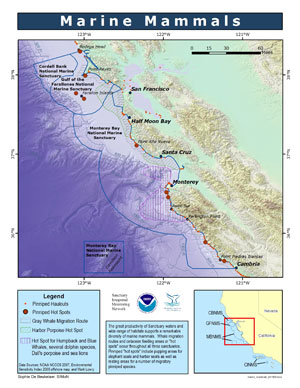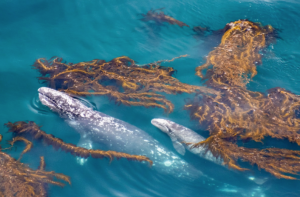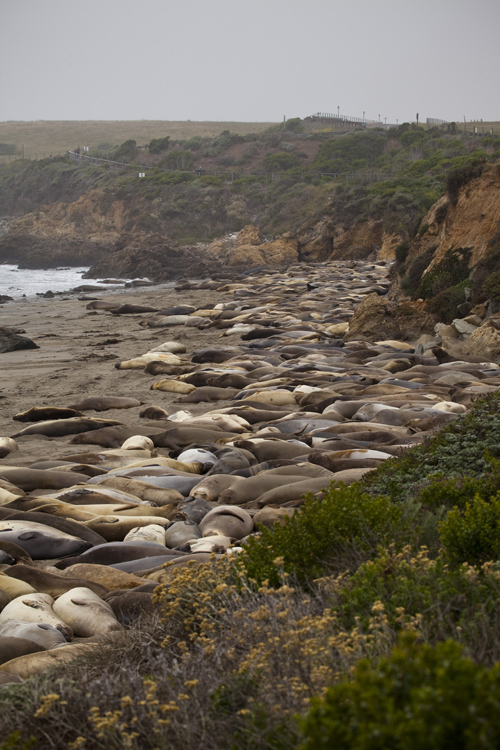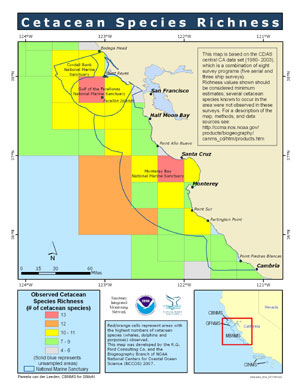The three northern California sanctuaries boast some of the most diverse and abundant marine mammal assemblages in the world. This is due to a number of factors, such as the region’s location on a migration pathway between Arctic feeding grounds and warmer breeding areas, the waters’ great productivity, and great habitat diversity.

The region’s marine mammal community is a mix of permanent and seasonal residents as well as species that use these waters for shorter periods – either as a feeding destination or in transit during long-distance migratory journeys (such as gray whales).
These waters are also important to several marine mammal species that are considered of special concern because of their reduced or declining populations. Examples include the humpback whale, blue whale, gray whale, northern fur seal and Steller sea lion.
Inhabitants
For more information on marine mammal populations specific to a particular sanctuary, please visit the individual pages for Cordell Bank, Greater Farallones and Monterey Bay. Below are examples of the species found in the northern California region:
Cetaceans
- Gray whale
- Humpback whale
- Blue whale
- Pacific white-sided dolphin
- Harbor porpoise
- Dall’s porpoise

Pinnipeds
Sea Otters

Conservation and Management Issues
Human impacts to marine mammal populations worldwide include competition for food with commercial and recreational fisheries, entanglement in fishing gear and other marine debris, disturbance and injury from ocean noise, injury or death from ship strikes, and, in some cases, residual effects from past harvesting or bycatch.
In addition to human impacts, changes in climate and oceanographic conditions affect marine mammals. The prevalence of these animals in sanctuary waters changes from year to year due to fluctuations in marine conditions such as El Niño.
Monitoring
Marine mammal-focused monitoring efforts in the northern California region are numerous and range from regional, multi-agency studies to more focused efforts. For a full list of each sanctuary’s monitoring efforts, see the individual monitoring sections for the Cordell Bank, Greater Farallones and Monterey Bay sanctuaries. A sample of research efforts is provided below.
The three sanctuaries are all participating in two studies whose geographic range reaches well beyond the sanctuaries’ own boundaries:
- Collaborative Survey of Cetacean Abundance and the Pelagic Ecosystem (CSCAPE) is a joint effort between the National Oceanic and Atmospheric Administration (NOAA) Fisheries and the National Marine Sanctuary Program to assess the abundance and distribution of marine mammals and characterize the pelagic ecosystem off the U.S. West Coast.
- Tagging of Pacific Pelagics (TOPP) , a pilot program of the Census of Marine Life, is part of an international endeavor to determine what lives in the world’s ocean. TOPP scientists explore the Pacific Ocean using satellite-tagged animals to gather data about their world.
The Cordell Bank and Greater Farallones sanctuaries are collaborating with scientists from other organizations in the region to investigate the spatial and temporal relationships among krill, krill predators and oceanographic processes:
- A project entitled Distribution and Abundance of Marine Birds, Mammals and Zooplankton Relative to the Physical Oceanography of the Greater Farallones and Cordell Bank aims to 1) understand the effects of varying oceanographic regimes on predator-prey relationships and food-web dynamics in the central California region and 2) provide a scientific basis for the design and implementation of a marine protected area.
The Monterey Bay and Greater Farallones sanctuaries are working together on several research initiatives. These include:

- Structure of Populations, Levels of Abundance and Status of Humpbacks (SPLASH) is an international cooperative effort to understand the population structure of humpback whales across the North Pacific and to assess the status, trends and potential human impacts to this population.
- NOAA Fisheries Gray Whale Stock Assessment is an ongoing project that conducts annual surveys of the gray whale population on its northward and southern migrations along the U.S. West Coast. Aerial surveys assess the health of cow-calf pairs, and land-based biologists observe group dynamics, behaviors and feeding activities.
- The Center for Integrated Marine Technologies’ (CIMT) Wind to Whales project uses emerging technology to assess the processes underlying the dynamics of the coastal upwelling ecosystems along the California coast.
The Monterey Bay sanctuary is involved in a number sea otter studies: